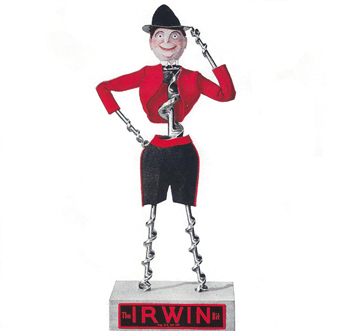The Irwin Auger Bit Company
Summary
 The Irwin Auger Bit Company, founded in Wilmington, Ohio, by Charles Irwin in 1885, went on to become a leading manufacturer of hand tools based on the quality of a single item—its innovative solid-center auger bit. After a rocky start, unexpected competition from the company treasurer's father, and devastating losses during the Panic of 1893, things took a turn for the better when its competitively priced augers developed a well-earned reputation for durability and value. By 1907, the company was doing so well it would have no qualms about claiming its auger operation as the "Largest in the World," a statement that was likely true.
The Irwin Auger Bit Company, founded in Wilmington, Ohio, by Charles Irwin in 1885, went on to become a leading manufacturer of hand tools based on the quality of a single item—its innovative solid-center auger bit. After a rocky start, unexpected competition from the company treasurer's father, and devastating losses during the Panic of 1893, things took a turn for the better when its competitively priced augers developed a well-earned reputation for durability and value. By 1907, the company was doing so well it would have no qualms about claiming its auger operation as the "Largest in the World," a statement that was likely true.
For half a century, Irwin focused almost exclusively on its augers and bits. Additional products came slowly. It added internally developed screwdrivers to its inventory in 1934 and chalk lines in 1960 when it acquired Strait-Line Products of Mesa, California. The product lineup remained relatively stable until 1981 when Irwin (now the Irwin Tool Company) purchased Roe International, a manufacturer of tape measures, and renamed its subsidiary the Irwin Measuring Tool Company. The new business wasn't a good fit. Just nine years later, it sold the operation to a former employee.(1)
Irwin's status as an independent company ended in 1993 when American Tool Companies, Inc. bought the business and renamed it Irwin Industrial Tools. American Tool had been organized by the Petersen family in 1985. The Petersens, owners of Petersen Manufacturing, manufactured the popular Vise-Grip locking pliers and folded their company into the new entity. Newell Rubbermaid, a massive conglomerate with a diverse portfolio, bought American Tool in 2002 and renamed it Irwin Industrial Tools. The move brought saw blades, clamps, Vise-Grips, and abrasive wheels to the Irwin brand. In 2016 Stanley Black & Decker acquired Irwin Industrial Tools as part of a larger transaction with Newell Brands, the formerly Newell Rubbermaid.
Seen on this page is Irwin, a one-time Irwin Auger Bit Company company mascot. The bit man first appeared in company publications in 1939 and remained in use for nearly two decades. A delightful bit of whimsy, Irwin bespeaks a simpler time in the American hand tool industry.
Illustration credits
- Irwin bit man: Irwin Wood-Boring Tools: Catalog No. 50. 1949.
References
- Muse, Louise. "Justus Roe and Sons Makers of Steel Tape Measures Since 1876." Chronicle of the Early American Industries Association. (December 2004), v. 57, no. 4, p. 135.